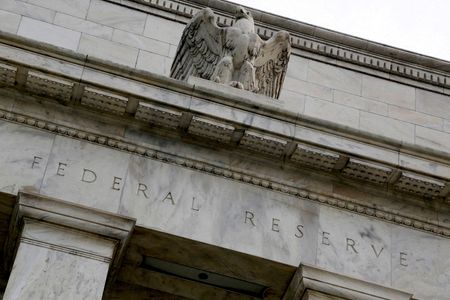By Jamie McGeever
ORLANDO, Fla. (Reuters) – If the Federal Reserve is to ease U.S. monetary policy this year, it may be a backdoor loosening around its quantitative tightening channel rather than lower interest rates.
The catalyst? The U.S. debt ceiling.
As yet another debt ceiling crisis looms – potentially the most rancorous to date – the Treasury will have to run down its cash balance at the Fed, with potential knock on effects on market liquidity, the yield curve, and even the dollar.
Absent congressional agreement to raise the debt limit, Treasury will run down the Treasury General Account, essentially its checking account at the Federal Reserve, to meet its federal obligations before running out of cash some time in June.
The TGA is a liability on the Fed’s balance sheet. This means that when the TGA goes down, reserves go up, effectively administering an injection of liquidity into the system.
GRAPHIC: TGA, reverse repos & bank reserves (https://fingfx.thomsonreuters.com/gfx/mkt/klvygzlgmvg/TGA1.jpg)
This runs counter to the Fed’s current stance of pursuing a tighter monetary policy, of which draining liquidity from the system via QT is a part.
“If the TGA is run down because of the debt ceiling, that will offset for a while some of the security maturation,” said Joe Lavorgna, chief U.S. economist at SMBC Nikko Securities.
The TGA is currently around $350 billion, well below where Treasury would like it to be and below its year-end target of $700 billion.
The Fed, meanwhile, is reducing its balance sheet by $95 billion a month via QT, allowing up to $60 billion of Treasuries and $35 billion of mortgage-backed securities to roll off.
Lavorgna’s central forecast is that around $300 billion of liquidity is drained from the financial system in the current quarter compared with the previous quarter – “a sizeable amount” comprised mostly of changes in the Fed’s securities holdings.
GRAPHIC: Fed liquidity vs S&P 500 (https://fingfx.thomsonreuters.com/gfx/mkt/xmvjklykypr/TGA2.jpg)
But he notes that Fed liquidity is actually up almost 1% so far this year, thanks to falls in the TGA and reverse repurchase facility – another liability on the Fed’s balance sheet – which have more than offset the decline in the Fed’s bond holdings.
Mark Cabana, head of U.S. rates strategy at Bank of America, calculates that since the Fed’s QT program got underway last May, the Fed’s balance sheet has shrunk by $406 billion and the TGA has dropped $422 billion.
“Fed QT to date has been largely absorbed by lower TGA,” he and his team wrote in a recent note.
GRAPHIC: Fed balance sheet since QT2 launch (https://fingfx.thomsonreuters.com/gfx/mkt/lgvdklglopo/QT.jpg)
THIS TIME IT’S DIFFERENT
Treasury Secretary Janet Yellen said earlier this month that the government is expected to reach its $31.4 trillion maximum borrowing capacity this week, before potentially running dry and risking default as early as June.
Economists and analysts had previously penciled in this so-called “X-date” for some time in the third quarter.
Congress has acted 78 separate times to “permanently raise, temporarily extend, or revise the definition of the debt limit” since 1960, according to the Treasury’s website. The most serious of all was in 2011, when ratings agency Standard & Poor’s stripped the United States of its AAA credit rating.
Perhaps counterintuitively, U.S. Treasury yields plummeted that year – the 10-year yield was up near 3.75% in February and by September it was as low as 1.75%.
As the “X-date” looms, investors are likely to build higher risk premia into short-dated Treasury bills that mature around that time.
Instead of rolling over their positions in these instruments, they may instead seek cash-like equivalents further out the curve, such as longer-dated Treasury notes.
On its own, this could deepen the already historic inversion across large parts of the yield curve: selling T bills pushes their yields up, and buying longer-dated paper pushes their yields down.
GRAPHIC: Historic US yield curve inversion (https://tmsnrt.rs/3IWMQRu)
The three-month/10-year yield spread already paints an astonishing picture. It is the most inverted in 40 years and has collapsed more than 350 basis points since May.
Alternatively, cash-like equivalents in safe, non-dollar securities like German bills and short-term bonds could be tempting for investors seeking refuge from a U.S. debt crisis and related instability.
Default has always been avoided in the past. But as the fractious and farcical saga of electing a new U.S. House of Representatives Speaker highlighted, Washington has rarely been more divided.
This time might really be different, and at the very least, the plumbing of the financial system – banks’ reserves, cash management and liquidity levels – will be tested.
“We’ve had a wide variety of debt ceiling experiences over the last 30 years. This appears likely to be high in the league table of unpleasantness,” said veteran Fed-watcher Lou Crandall, chief economist at money market research firm Wrightson.
(The opinions expressed here are those of the author, a columnist for Reuters.)
(By Jamie McGeever; editing by Diane Craft)

